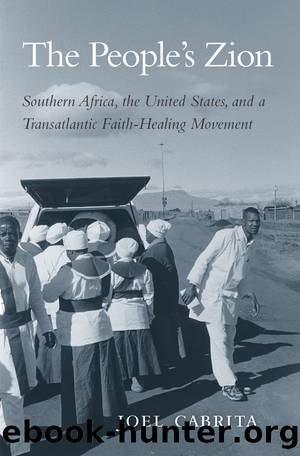The People's Zion by Joel Cabrita

Author:Joel Cabrita [Cabrita, Joel]
Language: eng
Format: epub
Tags: History, Africa, South, General, Religion, Christianity, Pentecostal & Charismatic, Social Science, Sociology of Religion, United States, 20th Century, Religion; Politics & State
ISBN: 9780674985766
Google: eyRgDwAAQBAJ
Publisher: Harvard University Press
Published: 2018-06-11T16:15:04+00:00
Educated Zionist ministers such as Phillips and Mabiletsa moved easily among the best of black Christian society. Mabiletsa, for example, sent his son, Phillip, to Fort Hareâthe leading African educational establishment of the dayâto work toward a BSc, where his teachers praised him as âa young man of exceptional intelligence with a special bent for the Sciences.â102 Mabiletsaâs new Zion Tabernacle in Alexandra was regularly patronized by luminaries of black society; a 1936 service featured one of the wives of Zulu regent Cyprian ka Solomon as well as the mayor of Alexandra and leading business owner and political leader, E. P. Mart Zulu.103 Then there was Zionist minister T. Mwelase, one of the few in Johannesburg still loyal to Voliva, and who was a respected local figure in his community, chairing rate payers association meetings in Sophiatown.104 Phillips, Mabiletsa, and other Zionist leaders frequently preached at the pulpits of the most prominent Ethiopian organizations. Phillips, for example, was invited to perform the ordination for Andrew Zungu, founder of the much-respected Congregational Church of South Africa, while Walter Ndebeleâs church was lent the building of the African Congregational Church for its own large services.105 Further suggesting Zionist leadersâ good standing within these elite circles, Bantu Worldâa chronicle of the black middle-classesâregularly reported on the doings of these figures; announcing in its news-about-town section, for example, that the âRev. Matthew Koza of Germiston [Phillipsâs senior minister] paid a flying visit to the Eastern Native township on business.â106 Mabiletsaâs activities were also a frequent presence in these pages,107 and in fact, during the 1930s, he acted as a seller and agent for Bantu World in Alexandra.108 Skotaâs African Yearly Registerâthe index of black luminaries of the interwar periodâlisted in its pages the âleading native ministersâ of the day, and included Rev. Walter Ndebele of the Christian Catholic Church in Zion.109
Not all Zionists in Johannesburg were as sympathetic to the values of the African Christian establishment. In the same period that saw the growth of Mabiletsa and Phillipsâs churches, an entirely more populist element began emerging within Zion. Older Zionists espoused the elitist confidence that education marked them out as natural leaders. Yet another strand existed within Zionist thought that argued Godâs work was carried out wherever the âSpirit blowethâ and denounced those who assumed education and training qualified them to be religious leaders. This attitude became even more pronounced in the Pentecostal movement of the early twentieth century, active in Johannesburg since 1908 in the form of the AFM and a host of other Pentecostal churches that subsequently cropped up in mining barracks. This was, after all, a tradition that in North America initially established no standard of education as necessary for ordination in any of its major denominations. And in the 1920s, a Pentecostal minister in England commented that the only preparation needed for ministry was a miraculous âupper-room experience.â110 In South Africa, Pentecostal-inspired arguments soon erupted in a falling-out between Mabiletsa, in Johannesburg, and Daniel Nkonyane in the Transvaal. Nkonyaneâwho had
Download
This site does not store any files on its server. We only index and link to content provided by other sites. Please contact the content providers to delete copyright contents if any and email us, we'll remove relevant links or contents immediately.
| Central Africa | East Africa |
| North Africa | Southern Africa |
| West Africa | Algeria |
| Egypt | Ethiopia |
| Kenya | Nigeria |
| South Africa | Sudan |
| Zimbabwe |
Goodbye Paradise(3460)
Men at Arms by Terry Pratchett(2686)
Tobruk by Peter Fitzsimons(2380)
Arabs by Eugene Rogan(2198)
Pirate Alley by Terry McKnight(2132)
Borders by unknow(2121)
Belonging by Unknown(1736)
It's Our Turn to Eat by Michela Wrong(1595)
The Biafra Story by Frederick Forsyth(1564)
Botswana--Culture Smart! by Michael Main(1487)
The Source by James A. Michener(1460)
A Winter in Arabia by Freya Stark(1449)
Gandhi by Ramachandra Guha(1437)
Coffee: From Bean to Barista by Robert W. Thurston(1422)
Livingstone by Tim Jeal(1396)
The Falls by Unknown(1374)
The Shield and The Sword by Ernle Bradford(1316)
Africa: Altered States, Ordinary Miracles by Richard Dowden(1296)
Egyptian Mythology A Fascinating Guide to Understanding the Gods, Goddesses, Monsters, and Mortals (Greek Mythology - Norse Mythology - Egyptian Mythology) by Matt Clayton(1279)
